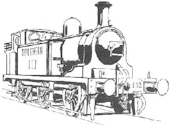 |
|
|
|
History of No.110
By the mid 1870's, there was a shortage of short-distance goods and pilot locomotives on the London, Brighton & South Coast Railway. As a result, a series of 0-6-0 tank locomotives were built at Brighton Works to the design of William Stroudley. No. 110 emerged from Brighton Works in March 1877 as the 100th locomotive built there. The locomotive was named 'Burgundy' and was allocated to Brighton depot. This event was later reported in the "The Locomotive" -
Extract from "The Locomotive" 15 September 1942 The locomotive was named 'Burgundy' and was allocated to Brighton depot. The whole class, totaling 78, was named after places from all across Europe as far as Hungary. The locomotive was built with a copper-capped chimney, crosshead pump and wooden brake blocks, and the boiler was pressured to 140 p.s.i. Around 1892, Westinghouse air brakes were fitted and by the mid 1890's, No. 110 was at Three Bridges. After 1905, the livery was changed from green to black and in 1923, No. 110 was taken into Southern Railway stock, and renumbered as 32110. The engine was noted at Tonbridge during the summer of 1925. Withdrawn from service in February 1927, No. 110 was sold on 5th April of that year to the Cannock and Rugeley Colliery Company for £925. A new boiler to a different design was made and fitted by Bagnalls of Stafford, resulting in a change of appearance (especially around the cab) and an increase in power due to an increased boiler pressure of 175 p.s.i. At Cannock Wood Colliery, No.110 was renumbered as No. 9, using the inverted number plate from No. 6, an 1876 engine which had been sold. As CRC No.9, the engine gave many years of good service, latterly in black livery and became the firm favourite with the enginemen due to its superior power over more modern machines. It was used extensively on the trip workings to Hednesford Canal Basin and the BR Exchange sidings on the ex-LNWR Cannock to Rugeley line.
Click on the above pictures for a larger versions Withdrawn for a second time in 1963, the engine was sold to the Railway Preservation Society and stored at Hednesford until 1970, when it was moved to the Chasewater railway. There it remained until sold to three members of the East Somerset Railway, finally arriving at Cranmore in September 1978. A general overhaul was commenced in 1986 and it returned to active service in 1993, painted in green livery and numbered 110. It pulled it first train in service on Sunday 24th October of that year. In 1996, No. 110 could be found transporting visitors to the Festival of the Sea on Bristols Harbour Railway. Unfortunately, firebox problems resulted in No. 110 being prematurely withdrawn from traffic in 1997. |